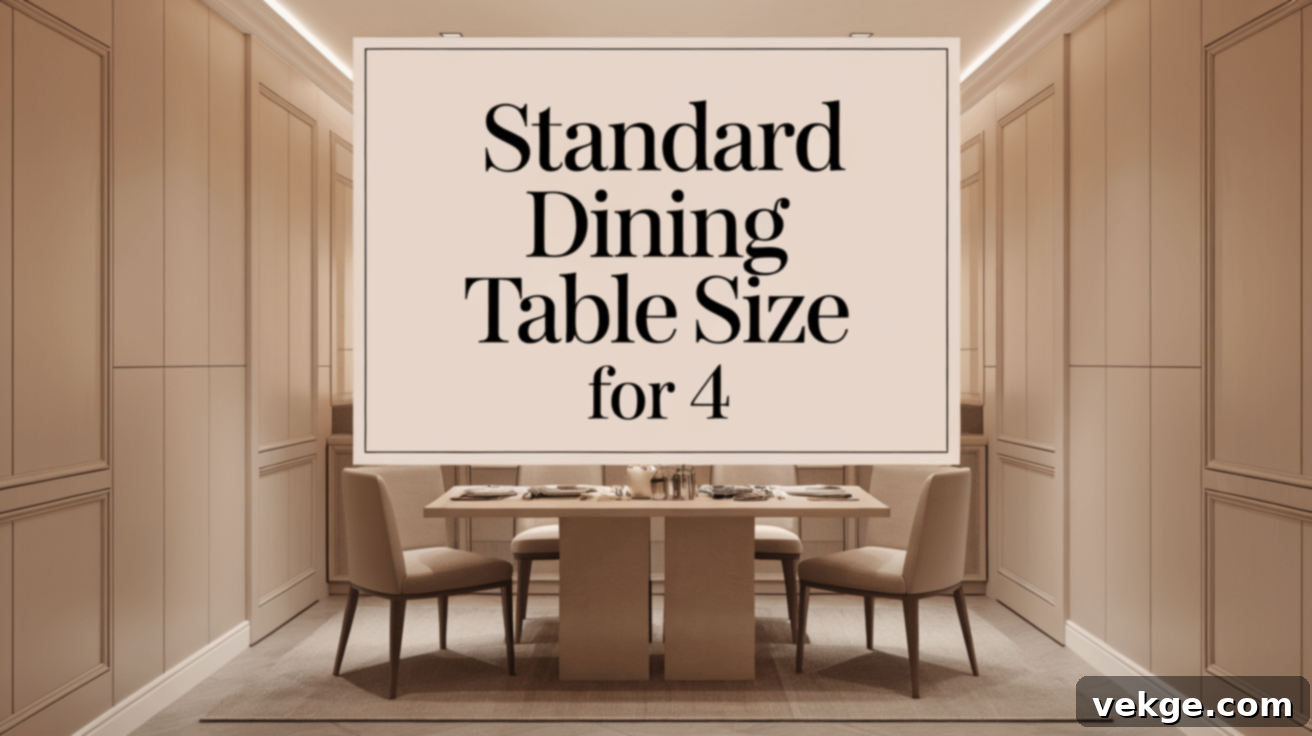Ultimate Guide to Choosing the Perfect Dining Table for 4: Sizes, Shapes, and Space Planning
Selecting the right dining table for your home is more than just picking a piece of furniture; it’s about creating a central hub for meals, conversations, and cherished memories. When you’re looking for a dining table designed to comfortably seat four people, the decision involves a thoughtful balance of comfort, style, and practicality. The perfect table will complement your home’s aesthetics while fitting seamlessly into your dining space without feeling either cramped or overwhelmingly large.
A table that’s too grand for its surroundings can dominate the room, making movement difficult and the space feel smaller. Conversely, a table that’s too small might leave guests feeling squished, lacking enough elbow room, or unable to properly display a meal. So, what exactly is the standard size for a dining table for 4? The answer isn’t a simple number, as it also depends on the table’s shape, the overall design, and the available space in your home.
In this comprehensive guide, we’ll delve into the ideal dimensions for a dining table built for four, helping you navigate the various shapes and styles available. We’ll explore crucial factors like the necessary clearance around the table, the best table shapes for different room layouts, and practical tips to ensure you make the best choice. Whether you’re furnishing a cozy apartment or a spacious dining room, our aim is to equip you with all the knowledge needed to find the perfect four-person dining table that truly elevates your home.
What is the Standard Size of a Dining Table for 4 People?
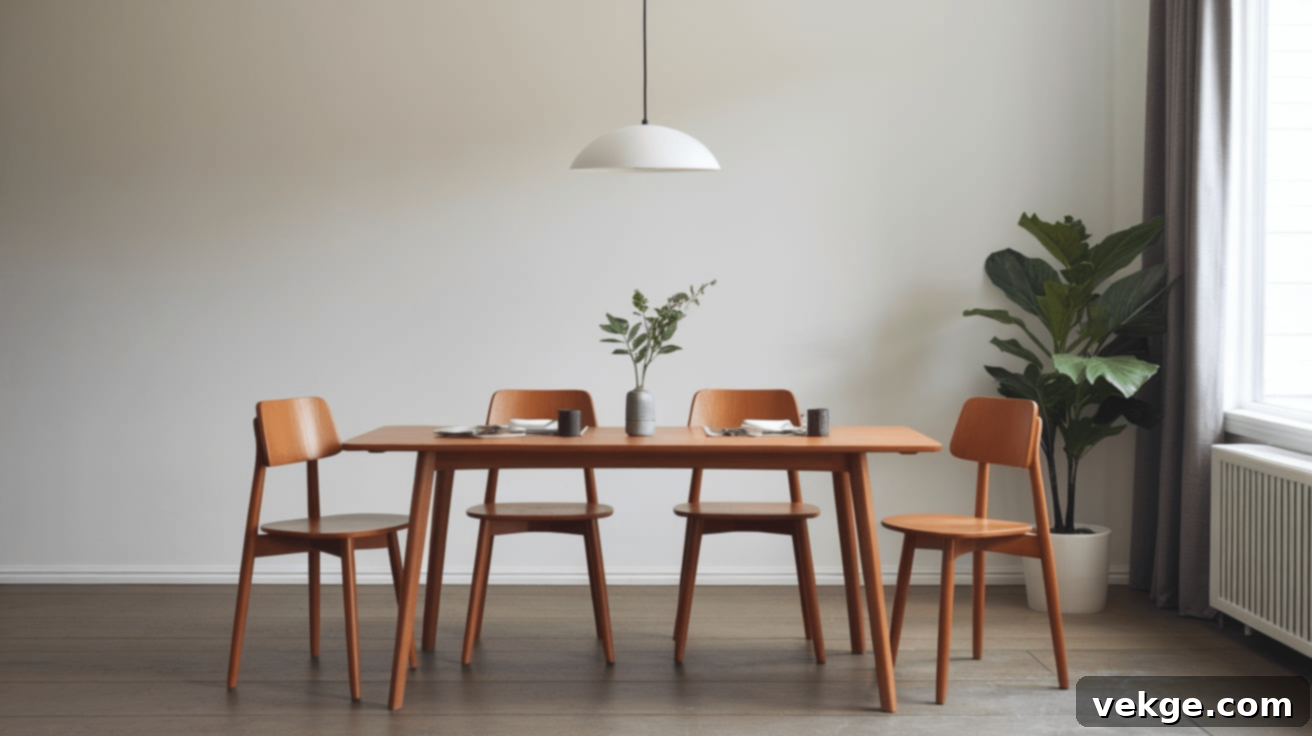
When searching for a dining table for 4, understanding the standard dimensions is your starting point. While there can be slight variations based on design and manufacturer, the most common and comfortable size for a rectangular dining table for four people is typically 48 inches long by 36 inches wide. This size strikes a good balance, offering ample space for four diners to sit comfortably, enjoy their meal, and engage in conversation without feeling cramped.
However, the concept of “standard size” expands when we consider different table shapes:
- For round dining tables, the ideal diameter for four people usually ranges from 42 to 48 inches. Round tables are excellent for promoting intimacy and conversation, as everyone faces each other equally. They are also often preferred in smaller spaces due to their lack of sharp corners, which can ease movement around the table.
- Square dining tables designed for four individuals typically measure between 36 to 48 inches on each side. Like round tables, square tables offer a balanced and intimate dining experience. They work particularly well in square-shaped rooms, mirroring the room’s dimensions for a harmonious feel.
These dimensions are crucial because they ensure each person has adequate “elbow room” and space for their plate, cutlery, and glassware. Overlooking these standard measurements can lead to a less enjoyable dining experience, even if the table looks good in the store.
Exploring Common Dining Table Shapes and Their Ideal Sizes for Four
Dining tables come in various shapes, each offering unique benefits and spatial considerations. Understanding these differences will help you choose the best fit for your lifestyle and dining area.
Rectangular Dining Tables
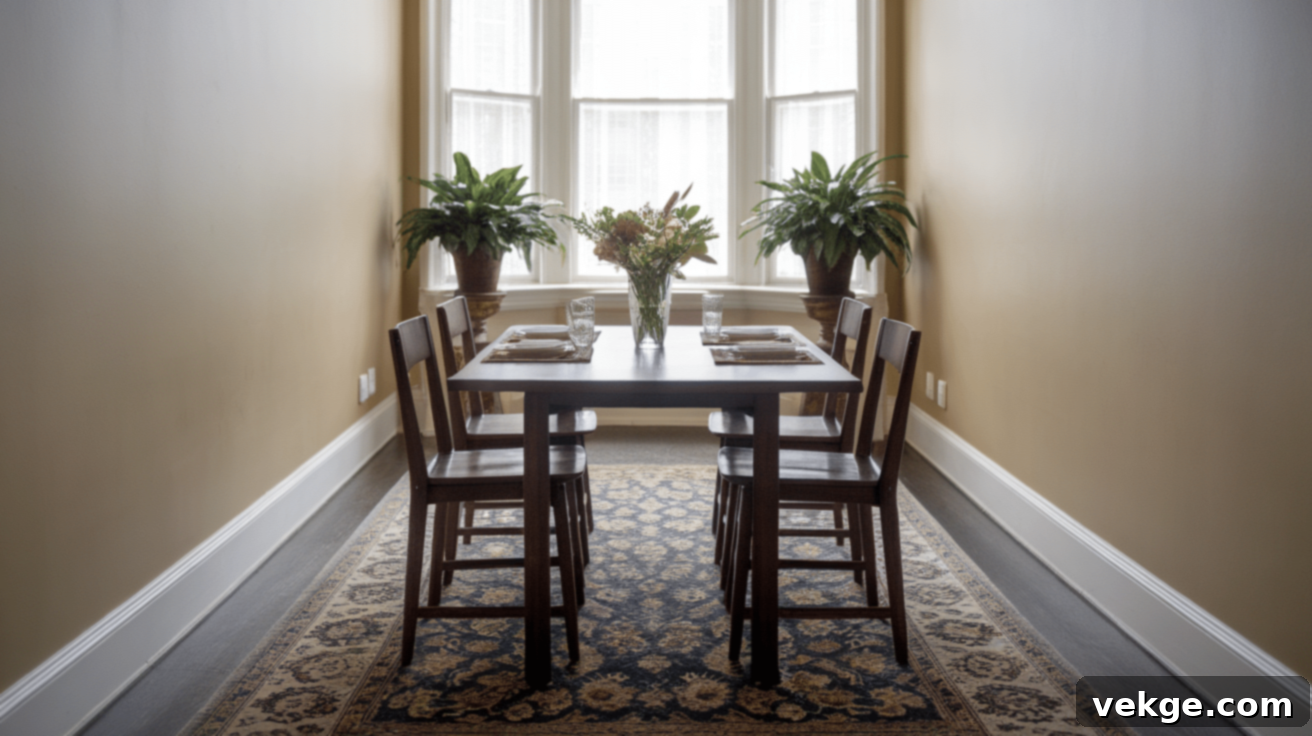
Rectangular tables remain the most popular choice for many households, especially for seating four people. Their linear design makes them incredibly versatile for various room layouts, particularly in longer, narrower dining rooms where they can visually extend the space. For four diners, a typical rectangular table should be approximately 48 inches in length and 36 inches in width. This configuration comfortably accommodates two chairs on each of the longer sides, ensuring everyone has sufficient personal space and room to dine without bumping elbows.
The advantages of a rectangular table extend beyond just fitting the space. They are excellent for formal settings, allowing for organized place settings and ample room for serving dishes in the center. Even when seating just two, a rectangular table offers flexibility, and many models come with extensions (leaves) that can temporarily expand the surface to host more guests, making them a practical long-term investment.
Round Dining Tables
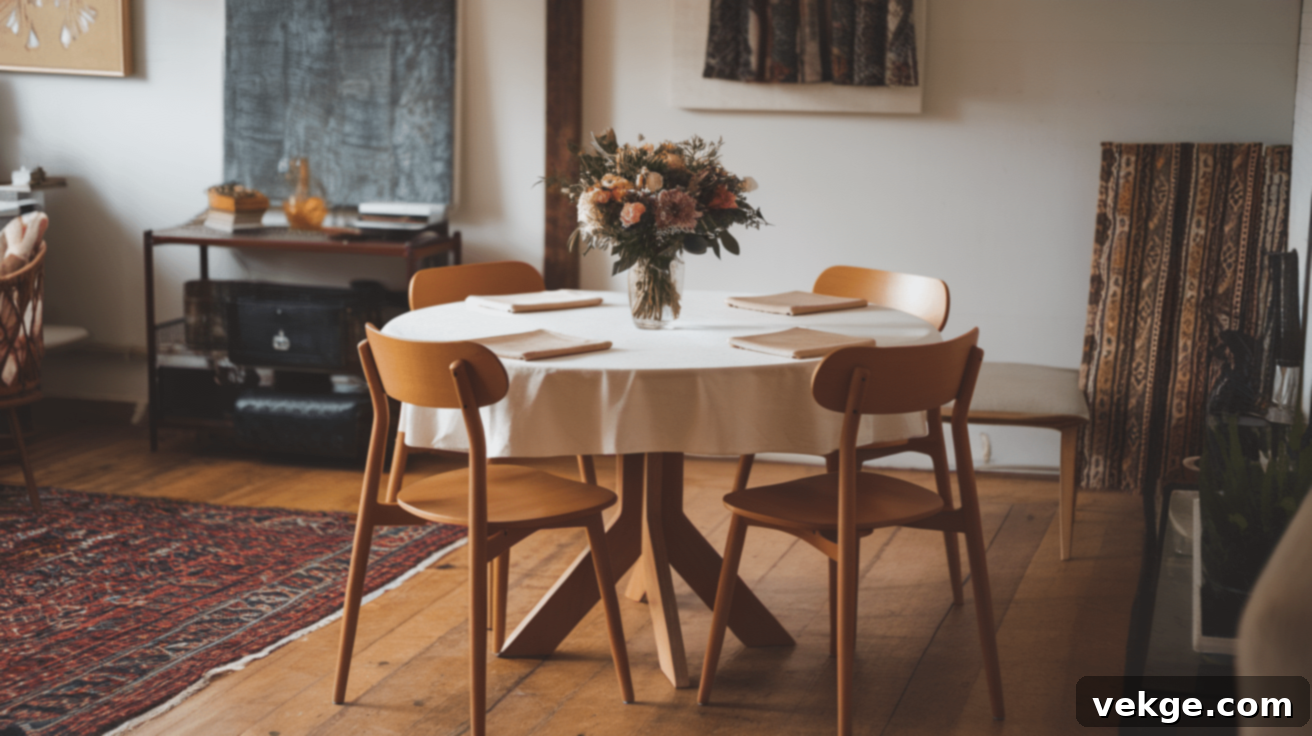
Round dining tables are an excellent choice for creating a cozy, intimate, and egalitarian dining experience. With no head of the table, everyone is equally engaged in conversation. For a table that comfortably seats four people, the ideal diameter typically falls between 42 to 48 inches. This size allows for comfortable seating and sufficient surface area for meals.
One of the primary benefits of round tables is their ability to fit well in smaller or irregularly shaped spaces. Without sharp corners, they promote easier movement around the table, reducing the likelihood of bumps or scrapes in high-traffic areas. This makes them particularly suitable for breakfast nooks, open-plan living areas, or dining rooms where space is at a premium. However, it’s worth noting that while they offer great flow, round tables can sometimes feel less efficient in terms of usable surface area compared to rectangular tables of similar footprint.
Square Dining Tables
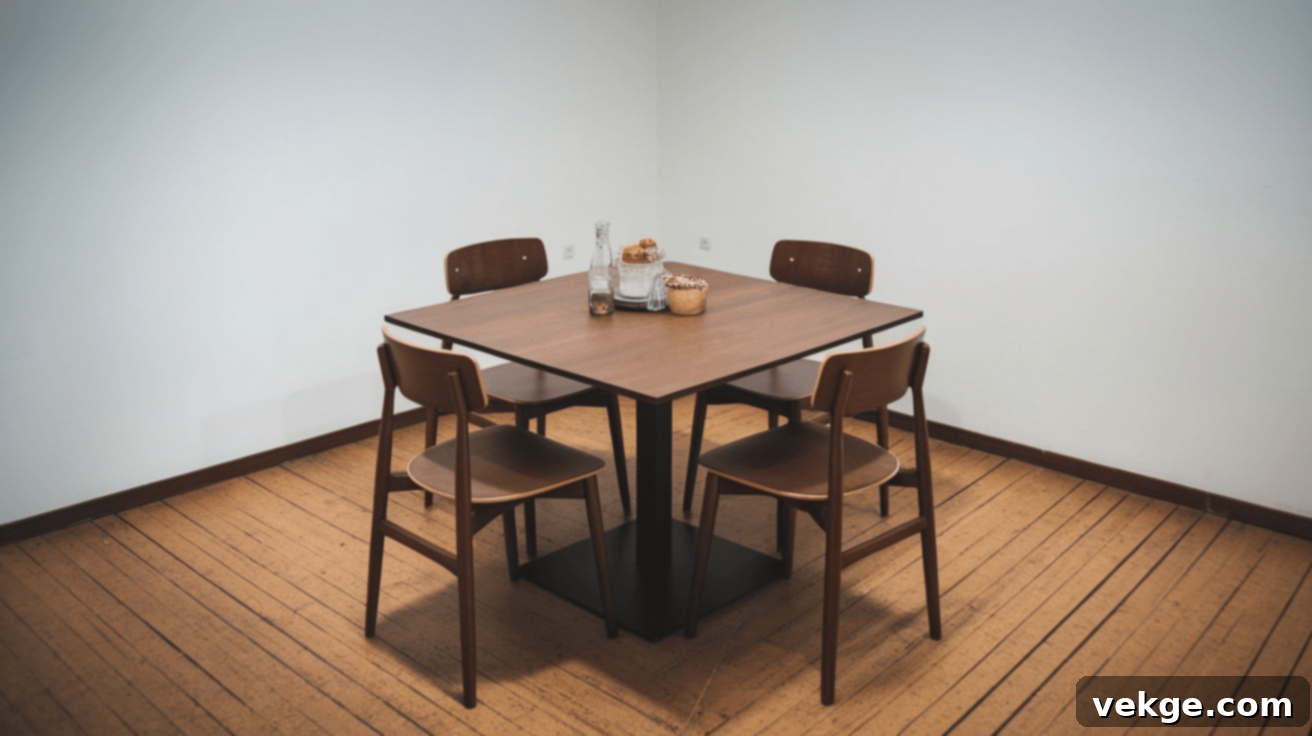
Square dining tables for four people are a fantastic option for rooms that echo their shape, providing a visually balanced and symmetrical look. While less common than rectangular tables for general use, they offer a uniquely intimate dining experience, similar to round tables, where everyone is equidistant and can easily converse. A typical square table for four will measure around 36 to 48 inches on each side.
These tables are particularly well-suited for smaller dining rooms or compact apartment spaces where maximizing floor area is key. They provide a compact footprint that can prevent a room from feeling overwhelmed. However, in much larger, expansive dining areas, a square table might feel a little lost or undersized, unless it’s designed to be part of a larger multi-functional space or can be expanded with leaves. They are perfect for small families or couples who frequently entertain one other couple, offering a perfectly proportioned setting.
Choosing the Right Table Shape for Your Space
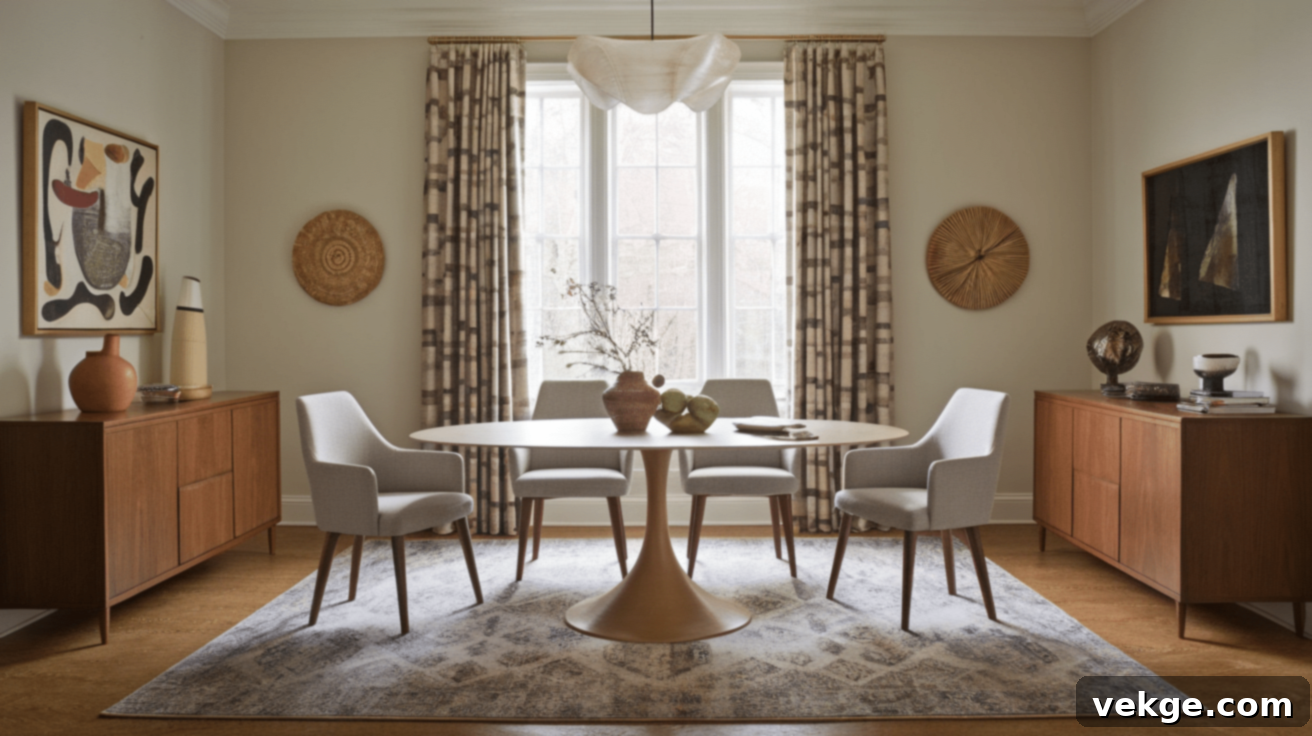
The shape of your dining table should ideally complement the shape and flow of your room. Thoughtful selection ensures both aesthetic harmony and practical functionality. Consider these points when matching table shape to your space:
- Rectangular Tables: These are the champions of longer, narrower rooms. Their elongated form mirrors the room’s dimensions, making the space feel more cohesive and allowing for easy movement along the sides. They are also highly adaptable if you need to occasionally squeeze in an extra chair at the ends.
- Round Tables: Best for small to medium-sized rooms, especially those with an open-plan layout or awkward corners. Their curvilinear design softens a room’s edges and promotes a more casual, shared dining experience. They also offer better traffic flow in tight spaces compared to sharp-cornered tables.
- Square Tables: An excellent choice for square-shaped rooms, as they provide a balanced look and make the most efficient use of a symmetrical space. They offer a compact footprint and can prevent a smaller room from feeling cluttered or overwhelmed by a larger, differently shaped table.
Understanding the Importance of Space Around the Table: Clearance and Traffic Flow
Beyond the table’s dimensions, the space surrounding it is equally critical for a functional and comfortable dining area. Neglecting this aspect can lead to a beautiful table that’s impractical to use.
Crucial Clearance for Chairs
For comfortable seating and ease of movement, it’s essential to leave adequate space between the edge of your dining table and any surrounding walls or other furniture. The general rule of thumb is to allow at least 24 to 30 inches of clearance. This measurement isn’t arbitrary; it ensures that:
- Diners can pull their chairs back fully to sit down and get up without bumping into obstacles.
- There’s enough room for people to walk comfortably behind seated guests, even when the chairs are occupied.
- The overall flow of the room is maintained, preventing a feeling of being squeezed or confined.
While 24 inches might be acceptable in very small spaces, aiming for 30 inches provides a noticeably more comfortable and luxurious feel, allowing for truly unrestrained movement.
Room Size and Table Size Harmony
Achieving harmony between your room’s dimensions and your dining table’s size is paramount. A simple rule of thumb: measure your room first, then subtract the necessary clearance on all sides to determine the maximum table footprint. For example, if your room is 10 feet wide (120 inches) and you want 30 inches of clearance on each side, your table should be no wider than 60 inches (120 – 30 – 30 = 60). This principle applies to both length and width.
- Small Rooms: In a compact dining area, a round or square table often outperforms a rectangular one. Their compact footprint and absence of sharp corners make them easier to navigate around, giving the illusion of more space. Pedestal bases can also free up legroom and visual space compared to tables with four corner legs.
- Larger Rooms: If you’re blessed with a spacious dining room, you have more flexibility. You might consider a larger rectangular table or one with a more substantial design. However, even in large rooms, maintaining proper clearance is vital to prevent the area from feeling disjointed or creating awkward traffic patterns. A large table in a large room still needs breathing room.
Understanding Dining Table Heights
While often overlooked, the height of your dining table significantly impacts comfort and the overall aesthetic. Dining tables typically come in three standard heights:
- Standard Dining Height: This is the most common, with tabletops usually ranging from 28 to 30 inches from the floor. This height is designed to pair perfectly with standard dining chairs, which typically have a seat height of 18-20 inches. It offers comfortable seating for most adults and is ideal for traditional dining experiences.
- Counter Height: These tables stand taller, usually around 34 to 36 inches high. They are often paired with counter-height stools (seat height 24-26 inches) and are popular in open-concept kitchens, breakfast nooks, or casual dining areas. Counter-height tables can create a more relaxed, communal atmosphere and can sometimes double as additional prep space in a kitchen.
- Bar Height: The tallest option, bar-height tables measure approximately 40 to 42 inches from the floor. These require bar stools (seat height 28-30 inches) and are typically found in home bars or very casual, space-saving dining setups. They offer a unique, elevated dining experience but might not be suitable for all ages or for very long meals.
When selecting your table, ensure the height aligns with your preferred seating style and the overall functionality you desire for your dining area. Always consider the chair height in conjunction with the table height for optimal comfort.
Ideal Dining Table Size for Different Room Shapes
The shape of your room is a primary determinant when choosing the ideal dining table size and shape for four. Matching the table to the room’s geometry creates a harmonious and functional space.
Long and Narrow Rooms
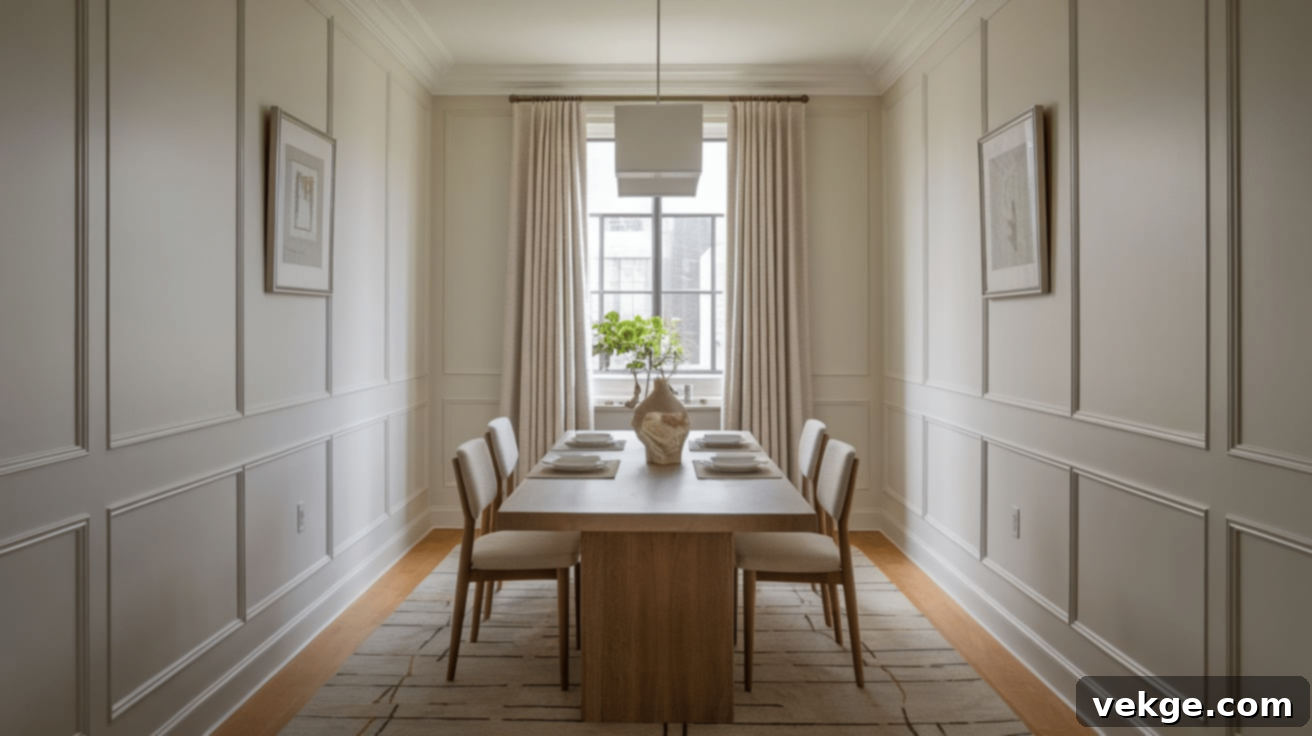
For long and narrow rooms, a rectangular dining table is almost always the best fit. Its elongated form naturally complements the room’s dimensions, creating a sense of balance and allowing for efficient use of space. A table that is too wide for such a room can make the area feel constricted, impede traffic flow, and lead to an uncomfortable dining experience. A rectangular table measuring around 48 inches in length and 36 inches in width for four people will perfectly align with the room’s flow without overwhelming it.
This shape also allows for easy movement along the longer sides, and if space permits, you can even add a slim console table or buffet along one wall without feeling overly crowded. The key is to maintain enough clearance on all sides, especially the shorter ends, to ensure chairs can be pulled out easily.
Square Rooms
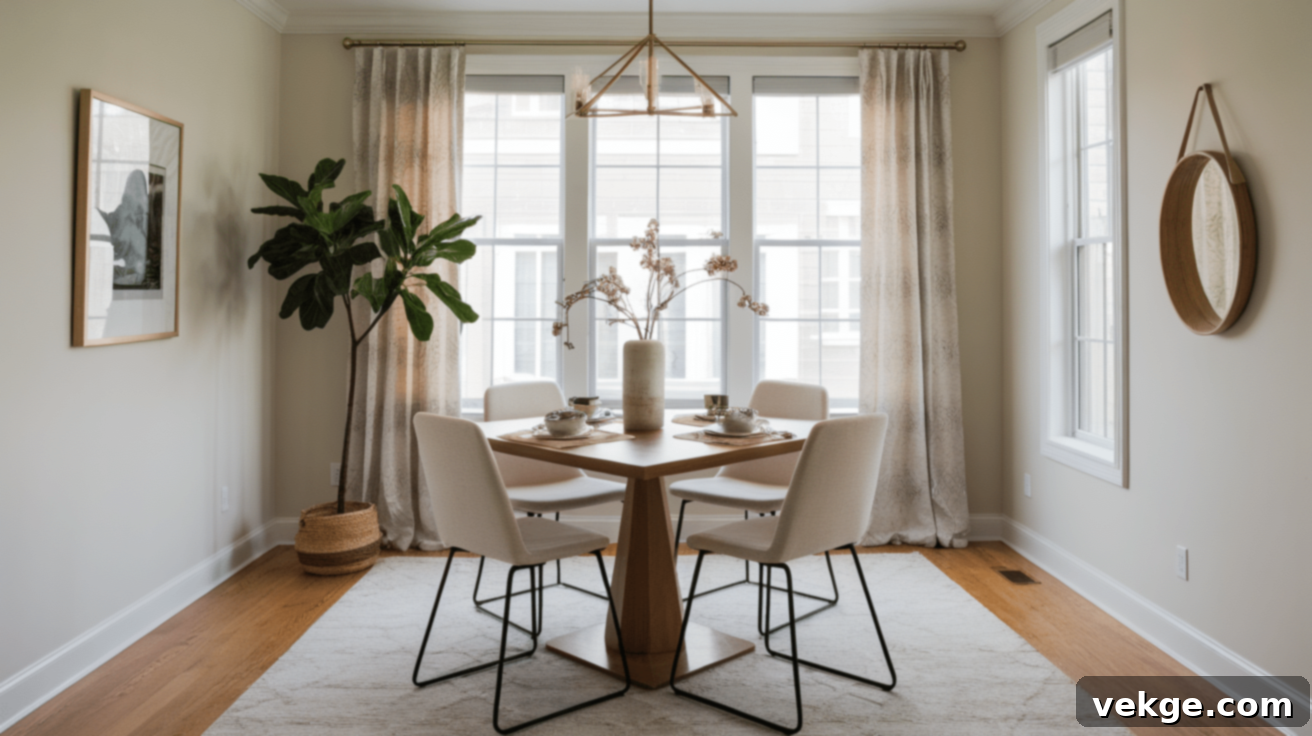
In square rooms, a square or round dining table generally works best. These shapes mirror the room’s symmetrical nature, promoting a balanced and aesthetically pleasing environment. A square table, typically measuring 36 to 48 inches on each side, will fit snugly while leaving ample surrounding space. This setup prevents any single wall from feeling neglected or overly crowded, distributing furniture evenly.
If you opt for a round table, a diameter of 42 to 48 inches is ideal for four people. Round tables are excellent for softening the potentially rigid lines of a square room and creating a more relaxed, communal atmosphere. They also offer flexible seating arrangements, as guests can easily slide around the perimeter. Both square and round tables in a square room contribute to a cohesive design, making the space feel purposefully designed rather than haphazardly furnished.
Large Rooms
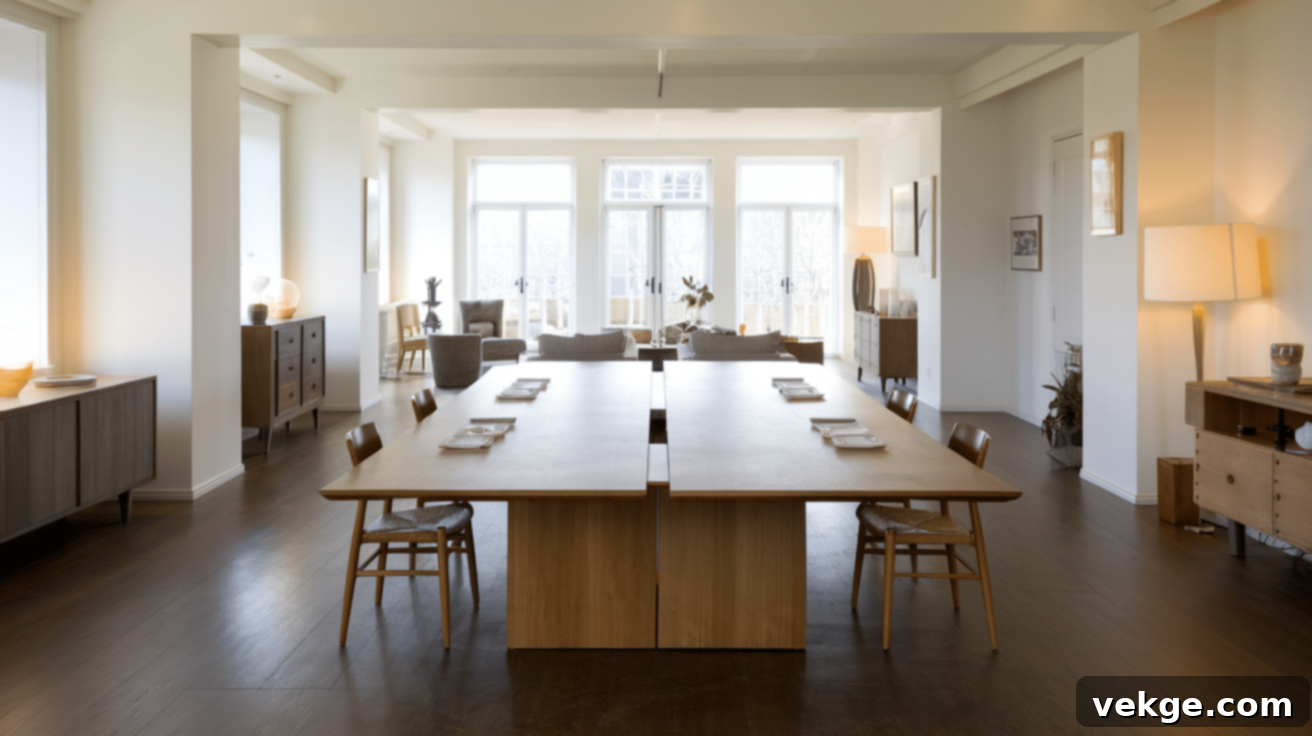
Spacious dining rooms offer a wonderful canvas for creativity and flexibility in table selection. While you’re looking for a table for four, a larger room might mean you can choose a more substantial piece that doesn’t get lost in the expanse. A rectangular table is often a natural fit for larger, longer rooms, allowing it to anchor the space effectively. You might even consider a rectangular table on the longer side of the 4-person spectrum (e.g., 54-60 inches long, which could technically seat 6 but offers luxurious space for 4), or one with a broader width, to fill the room more grandly.
Alternatively, a large round table (48 inches or slightly larger if you enjoy extra surface area) can also make a statement, fostering a grand yet intimate setting. The key here is not to undersize the table, which can make the room feel empty, but also not to overstuff it. Always remember to maintain generous clearance around the table to ensure effortless movement and to accommodate other dining room furniture like buffets, sideboards, or display cabinets. A larger space also provides an opportunity to choose a table with a more intricate base or a bolder design without it feeling overwhelming.
Small Rooms
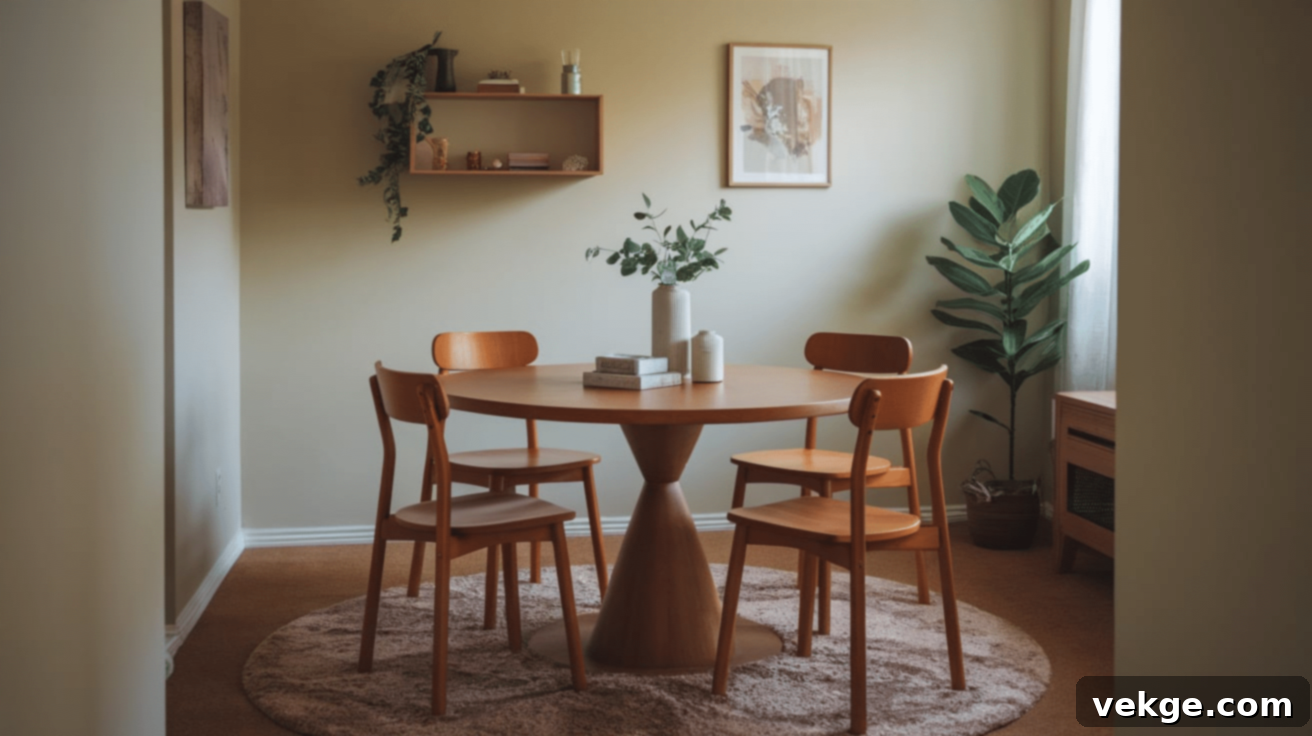
In smaller dining rooms, every inch counts, making strategic table selection crucial. For these compact spaces, a round or square table is typically the most efficient and practical choice for four people. Their smaller footprint and lack of sharp corners minimize obstructions and maximize the perception of open space. A round table with a diameter of around 36 to 42 inches is often ideal, as it allows for comfortable seating without making the room feel overly crowded. Square tables of similar dimensions (e.g., 36-40 inches per side) are also excellent.
Consider tables with a pedestal base rather than four corner legs, as this can offer more legroom and create a less cluttered visual. Drop-leaf or extendable tables are also brilliant solutions for small spaces, allowing you to expand the surface only when needed. Light-colored tables or those with glass tops can also help a small room feel brighter and more open. The goal is to choose a table that fits comfortably, allows for easy movement, and enhances the feeling of spaciousness rather than diminishing it.
How to Decide What Size Dining Table You Need for 4 People
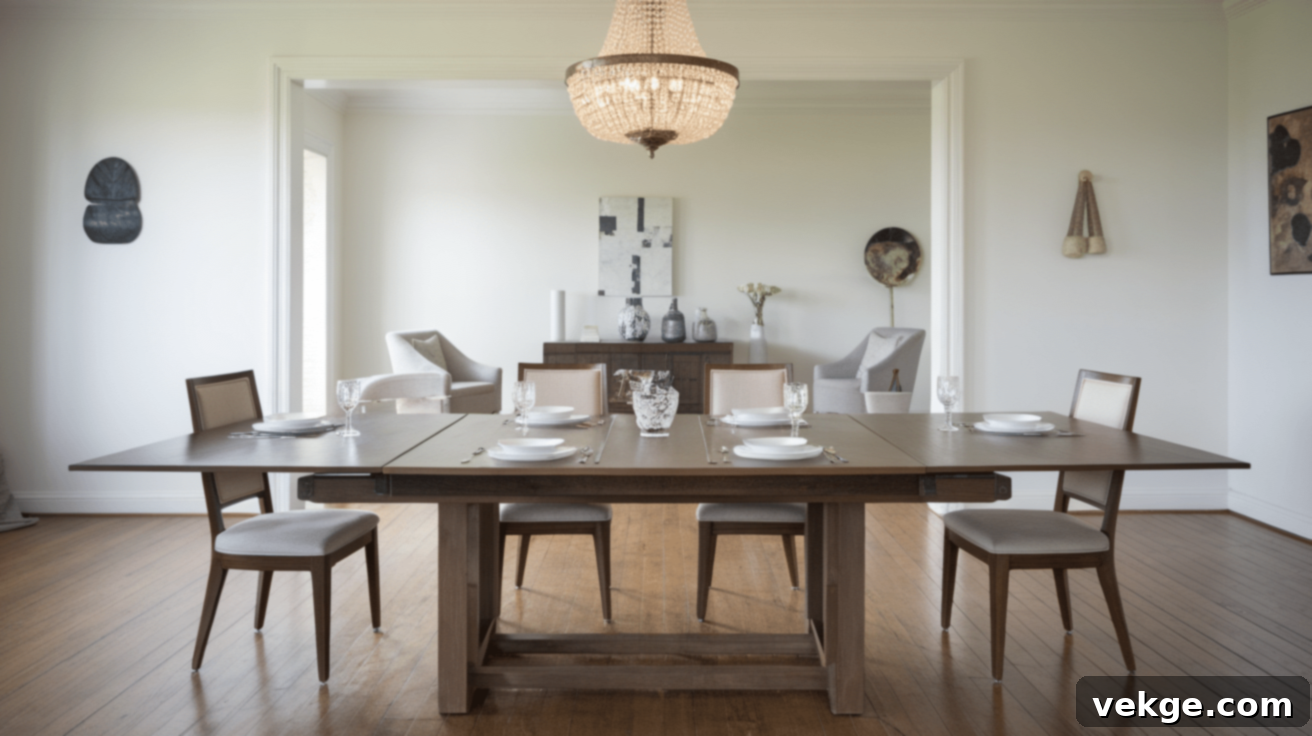
Making the final decision on your dining table for 4 involves a methodical approach, ensuring all practical and aesthetic considerations are met. Follow these steps to confidently choose the best table for your home.
1. Accurately Measure Your Space
This is the absolute first and most critical step. Begin by measuring the exact length and width of your dining room or designated dining area. Don’t forget to account for any architectural features like bay windows, built-in cabinetry, or radiators. Once you have your room dimensions, factor in the essential clearance space around the table. As a minimum, aim for 24 inches of clearance, though 30 inches is ideal for maximum comfort and ease of movement. Subtract this clearance from your room’s dimensions to determine the maximum possible length and width your dining table can occupy. A helpful trick is to use painter’s tape on the floor to visualize the table’s footprint and the surrounding clearance.
2. Consider the Table Shape in Relation to Your Room
With your room measurements in hand, think about how different table shapes will interact with your space. Rectangular tables naturally suit longer rooms, creating a streamlined look. Round and square tables, on the other hand, are often better for smaller or square-shaped rooms, promoting intimacy and efficient use of space. Visualizing the shape within your measured area will prevent a table from looking out of place or hindering traffic flow. Consider how the table’s shape will impact the room’s visual balance and overall functionality.
3. Prioritize Seating Comfort
While a table might technically fit four chairs, true comfort is about more than just fitting. Each person needs adequate space to sit, eat, and move without feeling confined. A general guideline is to allocate at least 24 inches of linear table edge per person. For a rectangular table seating two on each side, this means a minimum length of 48 inches. For round tables, ensure the diameter provides enough elbow room without making guests feel too far apart or too close. Also, consider the table’s leg design; a pedestal base can offer more legroom than tables with four corner legs, especially for those seated at the ends.
4. Account for Occasional Extra Guests
Even if you’re primarily shopping for a table for four, consider how often you might entertain additional guests. If hosting is a regular occurrence, an expandable dining table is an invaluable investment. These tables come with various mechanisms – butterfly leaves, drop-leaves, or separate inserts – that allow you to extend the tabletop surface to accommodate more diners temporarily. This flexibility means your table can serve its primary purpose for four while easily adapting to larger gatherings without requiring a second, larger table.
5. Keep Style and Aesthetic Harmony in Mind
Your dining table should be a focal point that enhances your home’s decor, not detracts from it. Consider the existing style of your dining room and the broader aesthetic of your home. Do you prefer a modern, minimalist look? A sleek glass or metal table might be ideal. Is your home more traditional or rustic? A sturdy wooden table with a classic finish would fit beautifully. The table’s material, color, and design should complement your existing furniture, wall colors, and overall desired atmosphere. A table that is disproportionate in size or clashing in style can disrupt the entire room’s balance.
6. Don’t Forget About Daily Functionality and Durability
Beyond aesthetics, a dining table must be practical for your daily life. If you have a busy family with children, durability and ease of cleaning will be paramount. Look for materials that are resistant to spills, scratches, and everyday wear and tear. Solid wood, tempered glass, or certain engineered materials can be excellent choices. Consider how the table will be used – is it just for meals, or will it double as a workspace, a homework station, or a craft area? Choose a table that can withstand your family’s lifestyle while retaining its beauty over time.
7. Test the Table’s Comfort (If Possible)
Before making a final purchase, if you can, try to physically sit at a table of similar dimensions in a showroom. Pull out a chair, sit down, and imagine a meal. Do you feel comfortable? Is there enough space to pull your chair back without hitting anything? Are your knees hitting the apron (the piece of wood under the tabletop) or legs of the table? This practical test can reveal comfort issues that measurements alone might not capture, helping you confirm that the chosen size truly works for you and your family.
What to Consider When Buying a Dining Table for 4 (Beyond Size)
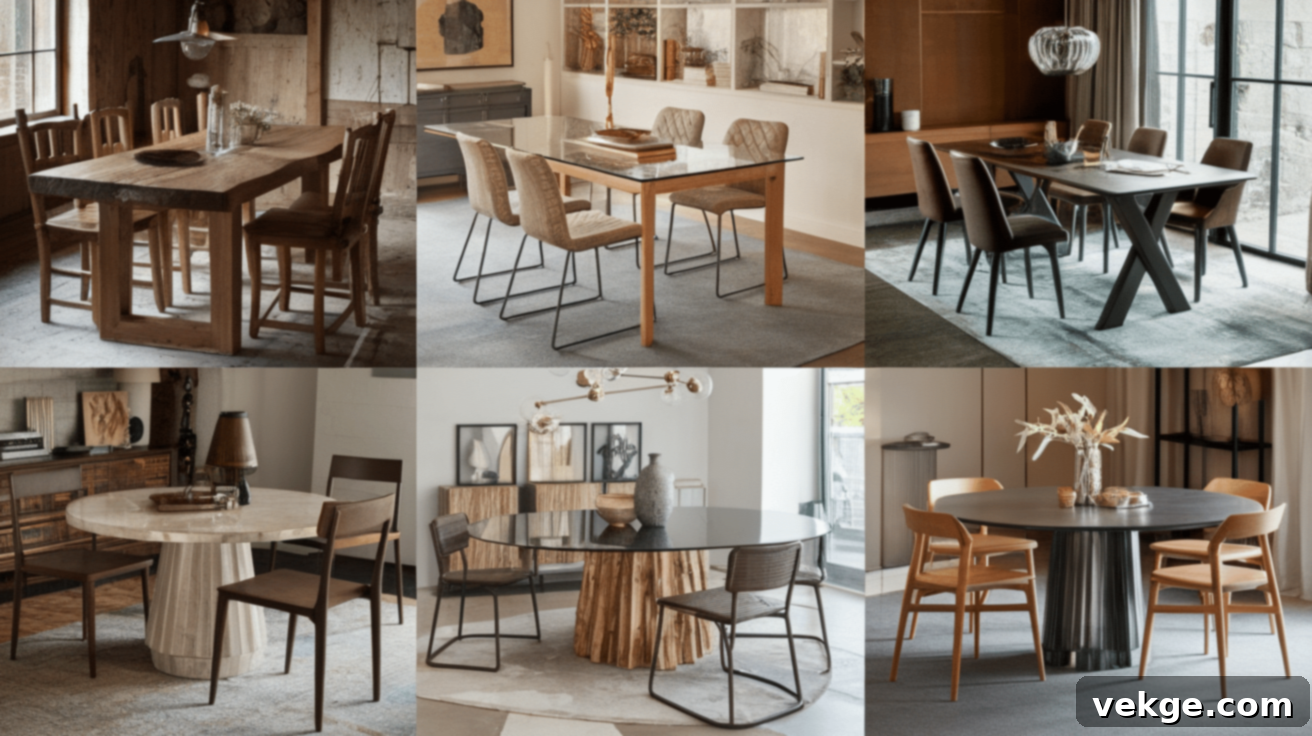
Once you’ve zeroed in on the ideal size and shape for your four-person dining table, several other crucial factors come into play that influence its longevity, maintenance, and overall impact on your home’s decor.
Material Matters: Durability, Maintenance, and Aesthetics
The material of your dining table profoundly affects its appearance, tactile feel, and how well it integrates with your existing home decor. Each material comes with its own set of characteristics:
- Solid Wood: A timeless and highly durable choice. Wood tables come in a vast array of finishes and wood types, from light, airy oak and pine to rich, dark walnut and mahogany. They are excellent for traditional, rustic, farmhouse, or even modern homes, depending on the design. Wood is sturdy, can be refinished, and develops a beautiful patina over time. However, it can be susceptible to scratches, water rings, and requires occasional polishing or sealing.
- Glass: Offering a sleek, modern, and often minimalist aesthetic, glass tables are fantastic for making smaller rooms feel larger and brighter, as light passes through them. Tempered glass is strong and resistant to heat, but surfaces can show fingerprints and smudges easily, requiring frequent cleaning. While durable, glass can chip at the edges or shatter under extreme impact.
- Metal: Tables with metal bases or full metal tops (like stainless steel, wrought iron, or brass) provide an industrial, contemporary, or even elegant touch. Metal is incredibly strong, durable, and generally low-maintenance. However, some metals can be prone to scratching, and the surface might feel cold to the touch. The design versatility ranges from chunky industrial designs to delicate, sculptural bases.
- Marble or Stone: For a touch of undeniable luxury and sophistication, marble, granite, or other stone tables are superb. These materials are incredibly durable, heat-resistant, and visually stunning, making a grand statement. They are, however, significantly heavier and often more expensive. Stone surfaces are porous and can stain if not properly sealed and maintained, and they can be chipped or cracked with heavy impact.
- Engineered Wood/MDF: Often a more budget-friendly option, engineered wood (like MDF or particleboard with veneers) offers a wide range of looks and colors. While generally less durable than solid wood, modern manufacturing techniques have greatly improved their quality. They are often lighter and easier to move but can be more susceptible to moisture damage and difficult to repair if scratched or chipped deeply.
Style and Design: Reflecting Your Home’s Personality
The style of your dining table should resonate with your personal taste and seamlessly integrate with your home’s existing decor. Whether your aesthetic leans towards farmhouse rustic, sleek modern, minimalist, traditional, or eclectic, there’s a table design to match. Consider the base design (pedestal, trestle, four legs), the edge profile (straight, beveled, live edge), and the overall silhouette. A table is a significant piece, and its style should contribute to the desired ambiance of your dining space.
The Perfect Pairing: Chairs and Benches
Your dining table isn’t complete without the right seating. For a table designed for 4 people, you’ll naturally need four chairs. However, consider the type of chairs. Do they have armrests? If so, ensure they can slide under the table comfortably. What about their width? Overly wide chairs can quickly make a four-person table feel cramped. You can also mix and match chairs for an eclectic look, or consider a dining bench for one side – benches are great for small spaces as they can tuck away neatly and often accommodate more people than individual chairs.
Ensure the chair’s seat height is appropriate for your chosen table height (e.g., standard chairs for standard tables, counter stools for counter-height tables). Comfort is key, so test chairs for back support and cushion firmness if possible.
Expandable Tables: Future-Proofing Your Dining Space
Even if you currently only need to seat four, life changes. An expandable dining table offers incredible versatility, allowing you to easily host more guests when the occasion arises. These tables incorporate various extension mechanisms, such as:
- Butterfly Leaves: These leaves fold and store neatly within the table’s frame, making expansion quick and effortless.
- Drop-Leaf Tables: Sections on the sides of the table can be folded down when not in use, perfect for very small spaces, and lifted to create a larger surface.
- Removable Leaves: These are separate panels that you insert into the table’s center or ends. They require storage when not in use but offer significant expansion.
An expandable table is a smart investment, providing flexibility without committing to a permanently large footprint.
Dining Table Tips for Small Spaces
Maximizing functionality and comfort in a small dining area requires clever choices. Here are some specific tips:
- Embrace Round or Square Tables: As discussed, these shapes take up less visual and physical space. A pedestal base further minimizes obstructions and maximizes legroom.
- Consider Drop-Leaf or Gateleg Tables: These designs allow you to collapse sections of the table when not in use, freeing up valuable floor space for other activities or easier movement.
- Opt for Lighter Colors and Materials: Light-colored wood, white finishes, or glass tops can make a small room feel airier and more open by reflecting light.
- Choose Armless or Slim Chairs: Armrests can add unnecessary width. Slim-profile chairs, or even benches that can tuck fully under the table, will make the area feel less cluttered.
- Utilize Bench Seating Against a Wall: If one side of your table is against a wall, a bench can be a space-saver. It eliminates the need for chair clearance on that side and can often seat more people than individual chairs.
- Look for Multi-Functional Furniture: A dining table that can convert into a console table or desk when not in use can be incredibly practical in studio apartments or very tight spaces.
Dining Table Tips for Larger Spaces
With more room, you have the luxury of bolder choices. Here’s how to make the most of an expansive dining area:
- Don’t Be Afraid of Size: A larger, longer, or wider table for four can anchor a big room and prevent it from feeling empty. Consider a table that allows for generous place settings and central decor.
- Choose a Statement Table: This is your chance to select a table with unique design elements, a striking material (like a live-edge wood slab or a dramatic marble top), or a robust base that acts as a sculptural element.
- Incorporate Additional Furniture: A larger room can comfortably accommodate complementary pieces like a grand buffet, a spacious bar cabinet, or a pair of elegant display cabinets without feeling cramped.
- Define the Zone: Use a large area rug under the table to visually define the dining space within an open-concept layout. The rug should extend beyond the chairs even when they are pulled out.
- Experiment with Seating: While focusing on four chairs, a larger room might allow for a mix of armchairs at the ends and side chairs, or even a banquette along one wall for a luxurious touch.
- Consider a Table with Extension Capabilities: Even if you normally seat four, a larger room means you’ll likely host bigger gatherings. An expandable table is a wise choice to future-proof your entertainment needs.
Conclusion
Finding the perfect dining table size for 4 people is a rewarding process that combines practical measurements with personal style. By understanding the standard dimensions for rectangular (48″ L x 36″ W), round (42-48″ diameter), and square (36-48″ per side) tables, you’ve taken the first crucial step. However, the journey doesn’t end there.
Remember that the shape of your room plays a significant role in determining the most suitable table shape. Rectangular tables excel in long, narrow spaces, while round or square tables are often superior choices for smaller or square-shaped rooms, promoting better flow and intimacy. Crucially, always factor in at least 24-30 inches of clearance around the table to ensure comfortable seating and effortless movement.
Beyond size and shape, consider the material for durability and maintenance, the style to harmonize with your home’s decor, and the chairs to ensure optimal comfort. Don’t overlook the versatility of expandable tables if you frequently host extra guests. By thoughtfully applying these guidelines, you can confidently select a dining table that not only fits your space perfectly but also becomes a cherished centerpiece for years of meals and memories.
Frequently Asked Questions About Dining Tables for 4
What is the standard size for a dining table for 4 people?
The standard size for a rectangular dining table for 4 people is typically 48 inches long and 36 inches wide. For a round table, an ideal diameter is between 42 to 48 inches, while a square table generally measures 36 to 48 inches on each side.
How much space should I leave around a dining table for 4 people?
It’s recommended to leave a minimum of 24 inches of clearance from the edge of the table to any wall or other furniture. For optimal comfort, ease of movement, and to allow chairs to be pulled out fully, aim for 30 inches of space. This ensures comfortable access for all diners and smooth traffic flow.
What is the best height for a dining table?
The most common and standard height for a dining table is approximately 28 to 30 inches from the floor to the tabletop. This height is designed to be comfortable for most adults when paired with standard dining chairs, which typically have seat heights of 18-20 inches.
How do I know if the table is the right size for my room?
To determine if a table is the right size, first measure your room’s length and width. Then, subtract the desired clearance (24-30 inches) from each side of the room’s dimensions. The remaining measurement indicates the maximum length and width your table should be. Additionally, visualize the table’s footprint using painter’s tape on the floor to get a realistic sense of its fit and traffic flow.
What if I occasionally need more seating than 4?
If you frequently host extra guests, an expandable dining table is an excellent solution. These tables feature built-in leaves or extensions that can be added to increase the tabletop surface, allowing you to comfortably seat more people when needed. This offers flexibility without requiring a permanently larger table.
Can I use a square table in a long, narrow room?
While square tables are ideal for square rooms, they can make a long, narrow room feel unbalanced and potentially hinder traffic flow if not carefully chosen. A rectangular table is generally preferred for long, narrow spaces as it complements the room’s dimensions. If you must use a square table, ensure it’s on the smaller side and positioned to allow ample clearance around it.
